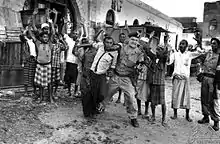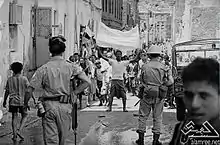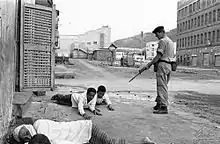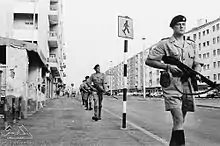| Aden Emergency | |||||||
|---|---|---|---|---|---|---|---|
| Part of the Cold War, the Arab Cold War, and the decolonization of Asia | |||||||
 The location of the Aden Protectorate | |||||||
| |||||||
| Belligerents | |||||||
|
Supported by: | |||||||
| Commanders and leaders | |||||||
|
|
| ||||||
| Strength | |||||||
|
(3,500 in November 1967)[2] |
| ||||||
| Casualties and losses | |||||||
|
British Army: Federal Regular Army: |
| ||||||
| Total: 2,096 casualties[5] | |||||||
The Aden Emergency, also known as the 14 October Revolution (Arabic: ثورة 14 أكتوبر, romanized: Thawra 14 ʾUktūbar, lit. '14th October Revolution') or as the Radfan Uprising, was an armed rebellion by the National Liberation Front (NLF) and the Front for the Liberation of Occupied South Yemen (FLOSY) against the Federation of South Arabia, a British Protectorate of the United Kingdom, which led to the proclamation of the People's Republic of South Yemen.
Partly inspired by Gamal Abdel Nasser's pan-Arab nationalism, it began on 14 October 1963 with the throwing of a grenade at a gathering of British officials at Aden Airport. A state of emergency was then declared in the British Crown colony of Aden and its hinterland, the Aden Protectorate. The emergency escalated in 1967 and hastened the end of British rule in the territory which had begun in 1839.
Background
Aden was originally of interest to Britain as an anti-piracy station to protect shipping on the routes to British India. With the opening of the Suez Canal in 1869, it further served as a coaling station. Over the period since the annexation of Aden, the British had signed many protection treaties with the emirs of the inland to secure British rule over the area. Following the independence of India in 1947, Aden became less important to the United Kingdom.
The Emergency was precipitated in large part by a wave of Arab nationalism spreading to the Arabian Peninsula and stemming largely from the socialist and pan-Arabist doctrines of Egyptian leader Gamel Abdel Nasser. The British, French and Israeli forces that had invaded Egypt following Nasser's nationalisation of the Suez Canal in 1956 had been forced to withdraw following intervention from both the United States and the Soviet Union.
Nasser enjoyed only limited success in spreading his pan-Arabist doctrines through the Arab world, with his 1958 attempt to unify Egypt and Syria as the United Arab Republic collapsing in failure three years later. A perceived anti-colonial uprising in Aden in 1963 provided another potential opportunity for his doctrines, though it is not clear to what extent Nasser directly incited the revolt in Aden, as opposed to the Yemeni guerrilla groups drawing inspiration from Nasser's pan-Arabist ideas but acting independently themselves.
Emergency
By 1963 and in the ensuing years, anti-British guerrilla groups with varying political objectives began to coalesce into two larger, rival organisations: first the Egyptian-supported National Liberation Front (NLF) and then the Front for the Liberation of Occupied South Yemen (FLOSY), who attacked each other as well as the British.
Hostilities commence
Hostilities started on 10 December 1963, with an NLF grenade attack against British High Commissioner of Aden Sir Kennedy Trevaskis, which took place as he arrived at Khormaksar Airport to catch a London-bound flight. The grenade killed the High Commissioner's adviser and a woman, and injured fifty other people. On that day, a state of emergency was declared in Aden.

The NLF and FLOSY began a campaign against British forces in Aden, relying largely on grenade attacks. One such attack was carried out against RAF Khormaksar during a children's party, killing a girl and wounding four children.
The guerrilla attacks largely focused on killing off-duty British officers and policemen. Much of the violence was carried out in Crater, the old Arab quarter of Aden. British forces attempted to intercept weapons being smuggled into Crater by the NLF and FLOSY on the Dhala road, but their efforts met with little success. Despite taking a toll on British forces, the death toll among rebels was far higher, largely due to inter-factional fighting among different rebel groups.
In 1964 the British 24th Infantry Brigade arrived to conduct land operations. It remained in Aden and the Aden Protectorate until November 1967.
By 1965, the RAF station RAF Khormaksar was operating nine squadrons, including transport units with helicopters and a number of Hawker Hunter fighter bomber aircraft. These were called in by the army for attacks on rebel positions in which they would use 60-pound high explosive rockets and their 30 mm ADEN cannon.
Aden street riots


On 19–20 January 1967, the NLF provoked street riots in Aden. After the Aden police lost control, British High Commissioner Sir Richard Turnbull deployed British troops to crush the riots. As soon as the NLF riots were crushed, pro-FLOSY rioters took to the streets. Fighting between British forces and pro-guerrilla rioters lasted into February. British forces had opened fire 40 times, and during that period there were 60 grenade and shooting attacks against British forces, including the destruction of an Aden Airways Douglas DC-3, which was bombed in mid-air, killing all the people on board.
Arab police mutiny
The emergency was further exacerbated by the Six-Day War in June 1967. Nasser claimed that the British had helped Israel in the war, and this led to a mutiny by hundreds of soldiers in the South Arabian Federation Army on June 20, which also spread to the Aden Armed Police. The mutineers killed 22 British soldiers and shot down a helicopter (The pilot had to abandon take off from a ledge near Crater, Aden after being hit in the knee by a bullet. The Sioux crashed and burnt out but all three occupants escaped), and as a result, Crater was occupied by rebel forces.
Concerns were heightened regarding the ability to give sufficient security to British families in the midst of the increased violence, resulting in evacuation plans for families being sped up considerably.
Battle of Crater
Following the mutiny, all British forces were withdrawn from Crater, while Royal Marines of 45 Commando took up sniping positions on the high ground and killed 10 armed Arab fighters. However, Crater remained occupied by an estimated 400 Arab fighters. NLF and FLOSY fighters then took to the streets and engaged in gun battles, while arson, looting, and murder was also common. British forces blocked off the two main entrances to Crater. They came under sniper fire from an Ottoman fort on Sira island, but the snipers were silenced by a shell from an armoured car. Order was restored in July 1967, when the 1st Argyll and Sutherland Highlanders entered Crater under the command of Lt. Col. Colin Campbell Mitchell and managed to occupy the entire district overnight with no casualties.
Withdrawal
Nevertheless, repeated guerrilla attacks by the NLF soon resumed against British forces, causing the British to leave Aden by the end of November 1967, earlier than had been planned by British Prime Minister Harold Wilson and without an agreement on the succeeding governance, effectively abandoning the South Arabian government. Following the British departure, the NLF quickly seized power, and established the People's Republic of South Yemen.
Aftermath
British military casualties in the period 1963 to 1967 were 90 to 92 killed[6] and 510 wounded. British civilian deaths were 17. Local government forces lost 17 killed and 58 wounded. Casualties among the rebel forces stood at 382 killed and 1,714 wounded.[4][3]
British units serving in Aden, 1963–1967


Royal Air Force
- No. 8 Squadron RAF with Hunter FGA.9[7]
- No. 21 Squadron RAF with Twin Pioneer CC.1, Dakota, Andover CC.2[8]
- No. 26 Squadron RAF with Belvedere HC.1[9]
- No. 37 Squadron RAF with Shackleton MR.2[10]
- No. 43 Squadron RAF with Hunter FGA.9[11]
- No. 78 Squadron RAF with Twin Pioneer CC.1, Wessex HC.2[12]
- No. 84 Squadron RAF with Beverley C.1[13]
- No. 105 Squadron RAF with Argosy C.1[14]
- No. 208 Squadron RAF with Hunter FGA.9[15]
- No. 233 Squadron RAF with Valetta C.1[16]
- No. 1417 (Fighter Reconnaissance) Flight RAF with Hunter T.7 & FR.10[17]
- RAF Police Joint Service Command
- No. 123 Signals Unit RAF
- No. 34 Squadron RAF Regiment 1965?
- No. 27 Squadron RAF Regiment 1965/66?
Royal Navy
- HMS Ashanti
- HMS Phoebe
- HMS Intrepid
- HMS Eagle
- HMS Bulwark
- HMS Albion
- HMS Minerva [ F45 ]
- HMS Centaur
- HMS Cambrian [D85]
Royal Marines
- 40 Commando RM
- 42 Commando RM
- 45 Commando RM
British Army

- 22 SAS Regiment
- Royal Armoured Corps
- Guards Division
- 1st Battalion, Coldstream Guards
- 2nd Battalion, Coldstream Guards
- 1st Battalion, Welsh Guards
- 1st Battalion, Irish Guards
- Infantry
- 1st Battalion, Royal Scots
- 4th Battalion, The Buffs (Royal East Kent Regiment)
- 1st Battalion, King's Own Royal Border Regiment (Various companies in support)
- 1st Battalion The King's Own Scottish Borderers
- 1st Battalion, Royal Irish Fusiliers B Company
- 1st Battalion, Royal Sussex Regiment
- 1st Battalion, Royal Northumberland Fusiliers
- Royal Anglian Regiment
- 1st Battalion, Royal Anglian Regiment
- 3rd Battalion, Royal Anglian Regiment
- 4th Battalion, Royal Anglian Regiment (1965)
- C Company (1967)
- 1st Battalion, Prince of Wales's Own Regiment of Yorkshire
- 1st Battalion, Lancashire Regiment
- 1st Battalion, Somerset and Cornwall Light Infantry
- 1st Battalion, King's Own Yorkshire Light Infantry
- 1st Battalion, Cameronians (Scottish Rifles)
- 1st Battalion, Argyll and Sutherland Highlanders
- 1st Battalion, Gloucestershire Regiment
- 1st Battalion, The South Wales Borderers
- Parachute Regiment
- Royal Artillery
- 1st Regiment Royal Horse Artillery
- 3rd Regiment Royal Horse Artillery
- 7th (Parachute) Regiment Royal Horse Artillery
- 19th Light Regiment Royal Artillery
- 47th Light Regiment Royal Artillery
- 95th Commando Regiment Royal Artillery
- Royal Engineers
- 10 Field Squadron (Airfields), Royal Engineers (Nov 1964 - 13 Dec 1967, last unit to leave)
- 13 Field Survey Squadron Royal Engineers (15 Jan 1964 - 29 Jun 1967)
- 24 Field Squadron Royal Engineers (15 Oct 1964 - 12 Jul 1965)
- 30 Field Squadron Royal Engineers (Sep 1966 - Apr 1967)
- 34 Independent Field Squadron Royal Engineers
- 2 Troop
- 39 Field Squadron Royal Engineers (Apr 1967 - Oct 1967)
- 50 Field Squadron Royal Engineers (Aug 1964 - ?)
- A Troop (Sep 1967 - Nov 1967)
- 60 Field Squadron Royal Engineers (Nov 1964 - Nov 1965, Mar 1967 - Oct 1967)
- 73 Field Squadron Royal Engineers (1965 - 1966)
- 131 Parachute Engineer Regiment (Territorial Army)
- 24th Brigade Postal and Courier Communications Unit Royal Engineers (1964 - 1967)
- Royal Corps of Signals
- 15 Signal Regiment Royal Corps of Signals (1965 - 1967)
- 222 (AF) Squadron Air Formation Signals (1959 - 1967)
- Royal Military Police
- Royal Corps of Transport
- Royal Electrical and Mechanical Engineers
- Royal Army Medical Corps
- 10 Bde. Grp. Medical Coy R.A.M.C.
- 24 Field Ambulance
- Royal Army Ordnance Corps
- Royal Army Pay Corps
- Army Air Corps (United Kingdom)
- Intelligence Corps (United Kingdom)
- Royal Pioneer Corps (518 Company)
- Army Catering Corps[18]
See also
References
- ↑ "Wars and Global Conflict: Confrontations and Hostilities". Modern-Day Commando. Archived from the original on 26 June 2014.
- ↑ "Aden Emergency". nam.ac.uk. Archived from the original on 28 July 2013.
- 1 2 3 4 "ADEN EMERGENCY PSYOP 1963–1967". PsyWar.Org. Archived from the original on 9 November 2020. Retrieved 22 April 2012.
- 1 2 Roll of Honor
- ↑ J. E. Peterson, British Counter-Insurgency Campaigns and Iraq. August 2009: p.12.
- ↑ http://www.adenveterans.org.uk/wp-content/uploads/2017/10/Roll-of-Honour_1.pdf%5B%5D
- ↑ Jefford 1988, p. 26.
- ↑ Jefford 1988, p. 31.
- ↑ Jefford 1988, p. 33.
- ↑ Jefford 1988, p. 37.
- ↑ Jefford 1988, p. 39.
- ↑ Jefford 1988, p. 48.
- ↑ Jefford 1988, p. 50.
- ↑ Jefford 1988, p. 54.
- ↑ Jefford 1988, p. 69.
- ↑ Jefford 1988, p. 75.
- ↑ Lake 1999, p. 88.
- ↑ All Units
Bibliography
- Jefford, C.G. (1988). RAF Squadrons. A comprehensive record of the movement and equipment of all RAF squadrons and their antecedents since 1912. Shrewsbury: Airlife. ISBN 1-85310-053-6.
- Laffin, John (1986). Brassey's Battles: 3,500 Years of Conflict, Campaigns and Wars from A–Z. London: Brassey's. ISBN 978-0-08-031185-2.
- Lake, A (1999). Flying units of the RAF. Shrewsbury: Airlife. ISBN 1-84037-086-6.
- Naumkin, Vitaly, Red Wolves of Yemen: The Struggle for Independence, 2004. Oleander Press. ISBN 978-0-906672-70-9
- Walker, Jonathan, Aden Insurgency: The Savage War in South Arabia 1962–67 (Hardcover) Spellmount Staplehurst ISBN 978-1-86227-225-5
External links
- Infantry Assistance From Outside Aden Archived 23 September 2015 at the Wayback Machine
- www.britains-smallwars.com – "The Barren Rocks of Aden".
- Argylls in Aden http://www.argylls1945to1971.co.uk/A_and_SH_Aden1967.htm
- Foreign Office documents concerning Aden, Yemen and the Aden emergency of 1963–1967